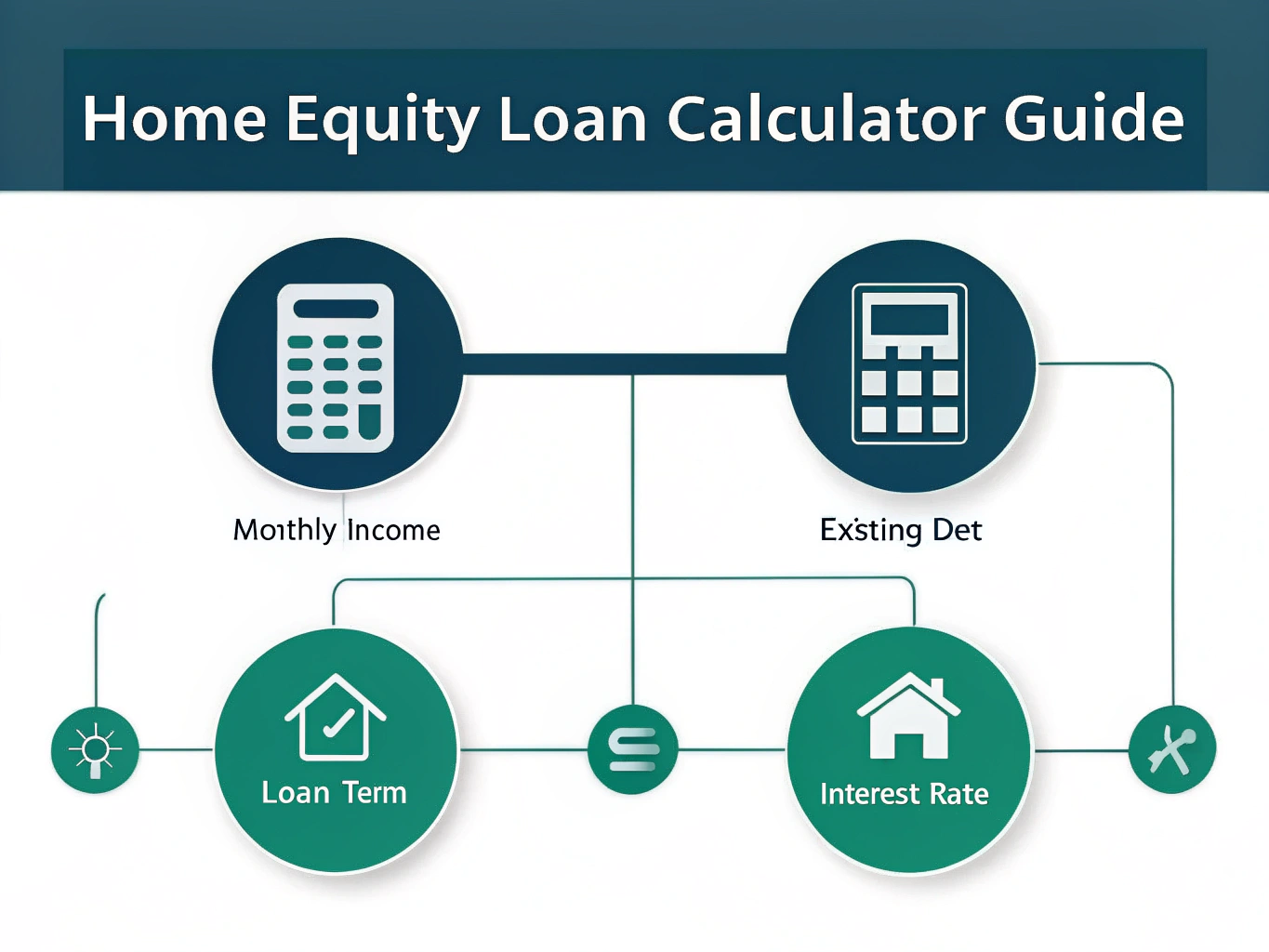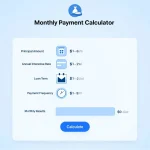Is this tool helpful?
How to Use the Home Equity Loan Calculator Effectively
Use this home equity loan calculator to find your maximum borrowing capacity by entering your financial details accurately. Here’s how to fill out each field:
- Monthly Income: Enter your total gross monthly income before taxes and deductions. For example, if you earn $6,200 monthly or $74,400 annually, input 6200.
- Monthly Debt Payments: Include all recurring debt payments like credit cards, car loans, or personal loans. If you pay $900 for car installments and $350 on credit cards, input 1250.
- Loan Term: Choose your loan’s repayment length — 15, 20, or 30 years. Longer terms lower monthly payments but increase total interest paid.
- Interest Rate: Provide the annual fixed interest rate as a percentage. For instance, enter 5.75 for a 5.75% interest rate from your lender.
What Is the Home Equity Loan Calculator and Why Use It?
This home equity loan calculator estimates the maximum loan amount you can afford based on your income, debts, loan term, and interest rate. It applies consumer-oriented debt-to-income (DTI) standards to help you make informed borrowing decisions.
Using this calculator gives you:
- Clear visibility into your borrowing limit before applying for a home equity loan.
- Insight into monthly payments to plan your budget comfortably.
- Compliance with recommended DTI limits to avoid overborrowing.
- Time savings with quick comparison of loan terms and interest rates.
Example Calculation Using the Home Equity Loan Affordability Formula
The calculator follows this formula to determine your maximum loan amount:
Where:
- r = annual interest rate (decimal form)
- n = total monthly payments (loan term in years × 12 months)
- 0.43 = maximum recommended debt-to-income (DTI) ratio of 43%
For example, if your monthly income is $7,000, your existing debts total $1,200, the interest rate is 6%, and you select a 20-year term:
- Calculate monthly interest rate: ( frac{6%}{12} = 0.005 )
- Calculate total payments: ( 20 times 12 = 240 )
- Maximum monthly debt capacity: ( 7,000 times 0.43 = 3,010 )
- Available amount for loan payment: ( 3,010 – 1,200 = 1,810 )
- Apply formula to find max loan amount using these values.
Benefits of Using a Home Equity Loan Affordability Calculator
- Accurate Financial Planning: Know your borrowing capacity before talking to lenders.
- Budget Control: Anticipate monthly loan payments to avoid surprises.
- Fast Scenario Analysis: Quickly experiment with different loan terms and interest rates.
- Responsible Borrowing: The tool aligns with CFPB DTI guidelines, encouraging safe borrowing limits.
- Informed Comparisons: Evaluate how altering loan lengths affects affordability.
Key Financial Planning Features
1. Debt-to-Income Ratio Management
The calculator uses a recommended 43% DTI limit, ensuring you don’t stretch your finances too thin. For example, if your income is $8,000 with debts of $1,600:
- Maximum debt-bearing capacity: ( 8,000 times 0.43 = 3,440 )
- Available for loan: ( 3,440 – 1,600 = 1,840 )
2. Affordable Payment Estimation
The calculator estimates loan amounts you can comfortably repay monthly. For instance:
- Monthly Income: $7,800
- Existing Debt: $1,900
- Interest Rate: 5.5%
- Loan Term: 15 years
- Maximum Loan Amount: $221,134
- Estimated Monthly Payment: $1,773
Practical Uses for the Home Equity Loan Calculator
Home Renovation Projects
Plan your renovation budget by understanding how much you can borrow. For example:
- Desired Project Cost: $60,000
- Monthly Income: $6,500
- Existing Debt: $1,000
- Check if the loan fits comfortably within your calculated borrowing limit.
Debt Consolidation Strategies
Use the calculator to compare debt consolidation options:
- Total Credit Card Debt: $28,000
- Personal Loan Balances: $20,000
- Evaluate different loan terms to find lower monthly payments and interest savings.
Funding Education Expenses
Plan education costs using your home equity loan affordability insights:
- Tuition & Fees: $45,000
- Books & Supplies: $4,000
- See if the loan amount supports your educational expenses while keeping your DTI healthy.
Frequently Asked Questions About Home Equity Loan Affordability
What factors determine my maximum loan amount?
Your gross monthly income, current monthly debt payments, interest rate, and chosen loan term all influence your borrowing capacity. Higher income and lower debts increase the maximum loan you qualify for.
How does selecting the loan term affect my monthly payment?
Longer loan terms spread payments over more months, lowering your monthly bill but increasing the total interest paid across the loan life. Shorter terms have higher monthly payments but cost less overall.
Can I use this calculator for different home equity loan types?
Yes, the calculator fits traditional fixed-rate home equity loans. Its principle works for most fixed-term products with consistent interest rates.
How do interest rates impact the maximum loan amount?
Higher interest rates reduce your maximum loan since a bigger share of your monthly payment covers interest, leaving less for principal repayment.
Should I include all debt types in monthly debt payments?
Include all recurring debts: credit cards, auto loans, student loans, and personal loans. This gives an accurate debt-to-income calculation and prevents surprises in your borrowing power.
How often should I recalculate my loan affordability?
Update your calculation when your financial situation changes—such as a raise, new debts, or significant interest rate shifts—to keep your borrowing estimate accurate.
Can couples calculate joint home equity loan affordability?
Absolutely. Combine both partners’ monthly incomes and debts to assess your shared borrowing capacity.
What if my monthly debts fluctuate?
Use average monthly debt payments based on your typical recurring obligations, ignoring sporadic or seasonal expenses for a realistic estimate.
Important Disclaimer
The calculations, results, and content provided by our tools are not guaranteed to be accurate, complete, or reliable. Users are responsible for verifying and interpreting the results. Our content and tools may contain errors, biases, or inconsistencies. Do not enter personal data, sensitive information, or personally identifiable information in our web forms or tools. Such data entry violates our terms of service and may result in unauthorized disclosure to third parties. We reserve the right to save inputs and outputs from our tools for the purposes of error debugging, bias identification, and performance improvement. External companies providing AI models used in our tools may also save and process data in accordance with their own policies. By using our tools, you consent to this data collection and processing. We reserve the right to limit the usage of our tools based on current usability factors.







